Raymond is slapping his four-foot-long machete on the Cohune Palm then he barks to the tribe of Howler Monkeys racing across the treetops. His command was a husky “AhhRoof!” that he repeated six or seven times over. Imagine our surprise when one of the young males clambered down to within twenty feet of us, easily using the dried and fresh vines of the rainforest as a big screen Spider Man uses his webbing.
Our morning started with breakfast in bed, courtesy the staff of Caribbean Beach Cabanas in Placencia. The day would be warm, sunny, and blue and the idea of slowly boating through a jungle was quite exciting. Jason, the owner of Truly Wild Belize, met us right on time at 8:00 am for the short drive to the dock where we met a smiling gentleman standing next to his twenty foot runabout.
“Hey good morning, I’m IanJohn.”
“Lo siento, tu nombre es?”
“IanJohn.”
“I’m John and this is my wife, Amy.”
“Well, I’m Ian, but my friends call me John.”
“Ahhh. Well Ian. I believe we’re in good hands this morning.”
I’ve been trying to brush up on my Spanish at every opportunity, however the Belizians often prefer to use English with the gringos, and that makes for an occasional awkward encounter. As we made our way out of the inlet and into the open water, the first thing Ian pointed out was the face of the sleeping Mayan. From the proper vantage point, the peaks of the Maya range appear to show the profile of a prone man. Much like the constellations, Mayans used this reference point to navigate across these dotted mangrove islands. Ian races across the open water and points us south towards the green landscape in the distance. As we enter the mangrove, he eases off the throttle and carefully winds his way through this green maze. This is likely what Florida’s Everglades once looked like, before we believed we could control the weather and our own landscape.
As we scoot through this saltwater forest, Ian narrates its history and importance while pointing out some its wildlife. The mangrove is a nursery and all manner of sea life come here to lay their eggs or raise their young. No sooner does he say that Amy spies a dozen large starfish, probably laying eggs. Much like our own sea oats and sand dunes back home, Mangrove also provide a buffer to the potential ferocity of the sea. Their dense root system traps flowing sediments which helps stabilize the coastline and prevents erosion. A healthy mangrove forest is critical to the health of the coral reef that parallels the shoreline of Belize, or anywhere there’s warm saltwater. Our ride to the tiny village of Monkey River, at the mouth of said river, takes us perhaps 45 minutes. Ian docks, offers us an opportunity to stretch our legs, use a bathroom, and enjoy a cold drink while he asks a local guide, Raymond, to join us.
Raymond is likely our age, and he moves like someone much younger. When I climb into a boat, especially a small one, I’m careful to keep my center of gravity low, and centered. The average water knowledgeable Belizian just clambers into his or her boat while somehow managing to remain upright and dry. A month earlier we’d bought fish from a gentleman easily six feet and four inches tall. After I asked him if I might take his photo, he smiled, stepped into his five-foot-long kayak, bent over and hoisted a large Horse Eye Jack, and smiled. You think your morning yoga helps with balance? Well give that exercise a try.
Raymond was armed with nothing more than the favorite tool of Central America, a large machete. It’s used to landscape, to navigate, to access fresh coconut water, and occasionally to rattle a tree full of monkeys. Ian pointed us up the river and Raymond took over the narration. Raymond is a native of Monkey River village, and he’s been guiding for many years and sadly knows the village will soon be gone. Farms upriver have damned the Monkey for irrigation, slowed its flow of sediment which keeps the shoreline healthy. As the shoreline has receded it’s taken the village with it. What was once home to several thousand now numbers in the low hundreds.
“Look! Aracari!”
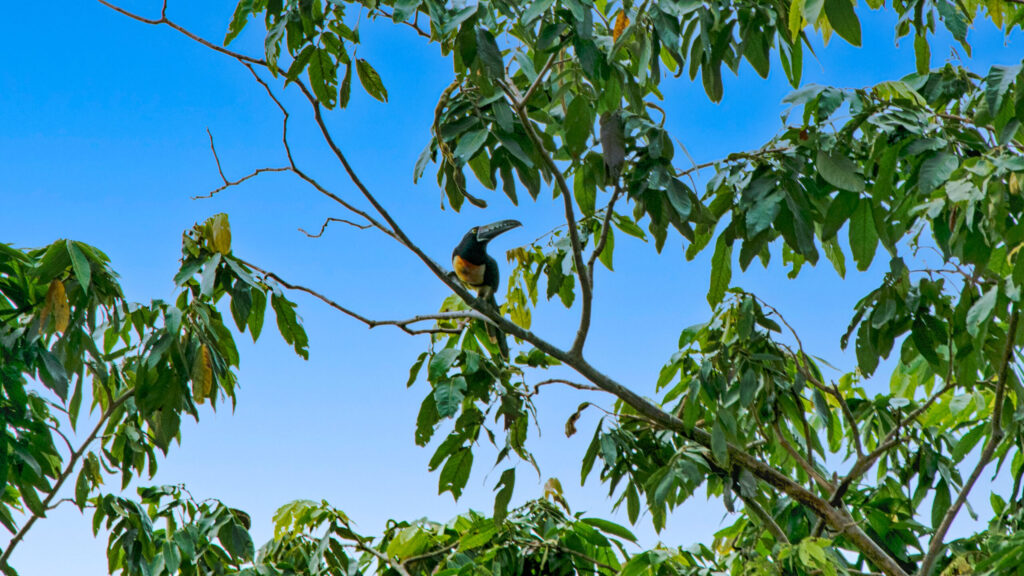
Ian eases off the throttle as Raymond gives us specific instructions to find these members of the Toucan family. Amy has her binoculars; I’ve got the long lens on my Nikon and we don’t see anything yet.
“Up that tall tree, far edge of the highest limbs, at your eleven o’clock.”
Finally, Amy spies them. They’re chattering away, five or six of them.
“Toucanettes. Little Toucans they’re called. Actually, Collared Aracari because of that dark band around their waist. Very hard to tell the difference in males and females so this may be three sets of mating birds.”
I’m snapping away and bemoaning the poor lighting and grey skies when Raymond asks me if I know photoshop.
“You gonna have to replace the sky in those shots.”
Ian gives his boat a little power and further south we go.
“Tiger Heron!” whispers Raymond, pointing around the bend. And ten seconds later a large male comes into view. How the hell can he see through the trees and so far over the horizon?
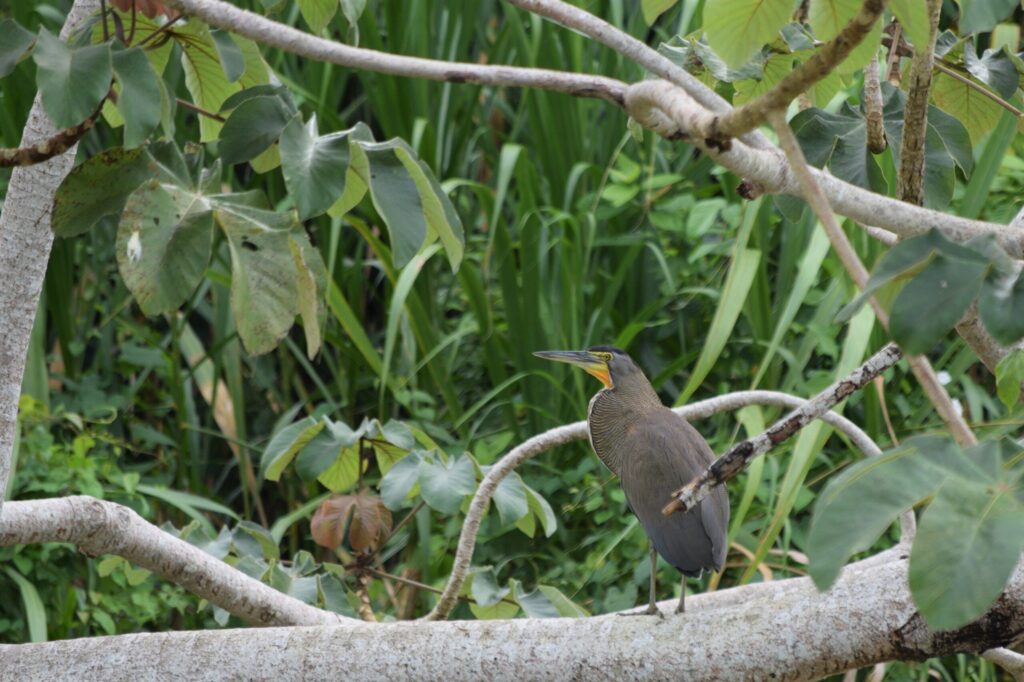
As we putt-putt past the Tiger Heron, Raymond points out a house, once a home for university students working on their master’s thesis, now settling into the water.
“Just a few years ago that house had ten feet of riverbank in front of it, now look. I’m afraid that’s the future of my village, too.”
Raymond says that without a hint of sadness, it’s a matter-of-fact observation and given the ravages of Covid19 on the psyche of the globe, to Raymond that house represents more than just a rapidly shifting river.
A large rusty red bird flaps passes over us, perhaps twenty feet high as Raymond and my bride shout out simultaneously “Squirrel Cuckoo!”
This cuckoo is about the size of a large pigeon, with a tail as long as its body, alternating black and white bands on that tail and a rust red body. Amy’s lightning quick identification impresses Raymond and he responds with “Yes mum.”

A few minutes later and Ian points his boat at a small muddy spot on the shoreline. Raymond picks up his machete and asks us if we’re ready.
“Oh, we’re getting out?”
Amy gives me a thumbs up. I guess I missed that “hiking” part in the tour’s description and try to remember how much Off! we applied earlier. We’ve left our hiking shoes and sturdy pants back in San Pedro yet as the boat comes to a stop, Raymond, dressed in a pair of rough-hewn shorts, collared pull over and sandals beckons us to follow. Oh well, let’s go hiking.
This a rainforest, it averages about 100 inches of rain annually. Its treetops tower over us and the forest floor teams with undergrowth of all shapes and sizes. As we start out Amy asks about snakes, and her favorite, spiders.
“We won’t see any tarantulas, mum, they don’t like the sound of all these footsteps.”
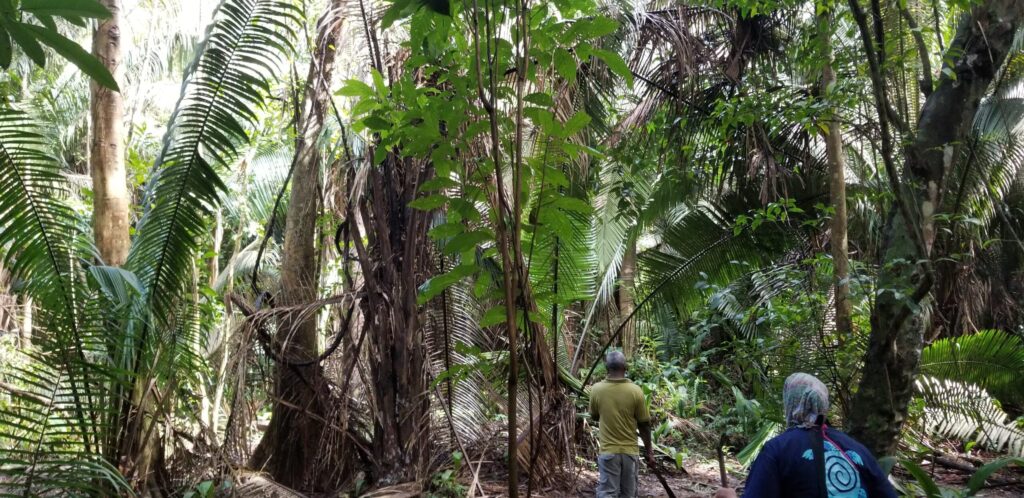
A few years back, while on a guided hike through a national park in the Bahamas, Scott Johnson our guide, a science officer with the National Trust casually pointed out a tarantula nest to my wife with an “Oh cool. Miss Amy look at this!” He grabbed a twig and began tickling the webbing covering a chipmunk-sized hole.
“What is it, Scott?”
At the words “Bahamian Tarantula nest” Scott may as well have said “live hand grenade” and received the same reaction from my bride. I couldn’t get out of her way fast enough. And here we are, once again in tarantula country with an overly curious guide. She stopped walking, shoved me in front of her but not before picking up an appropriate tarantula bashing stick.
“Raymond this isn’t poisonwood, is it?”
“No mum.”
Belize only became independent from Great Britain about 40 years ago and gentlemen of a certain age still pronounce “ma’am” as “mum”. It’s quite genteel to hear even if that particular mum is ankle deep in mud ready to whack a coffee mug sized spider into the treetops.
“You know about Poisonwood and the Gumbalimba? The Good Lord gave you an antidote for the Poisonwood so if you ever touch one, look nearby and you’ll see a Gumbalimba tree. Use its bark to rub on you and it pulls the sap of the Poisonwood off.”
“Seriously?”
“Yes mum. The Good Lord works in mysterious ways, doesn’t he?”
Poisonwood trees dot the Caribbean landscape and are related to Poison Sumac and Poison Oak. Its sap produces a nasty reaction and this tree also resembles a number of its neighbors. The Gumbalimba is locally referred to as the tourist tree as it turns red and peels. And that means it’s relatively easy to identify. And these two just so happen to grow and prosper in each other’s company.
“Jaguar.”
“Where?”
Raymond is so nonchalant and I’m turning this way and that searching for a big cat.
“Right here, mum.”
“Wow!”
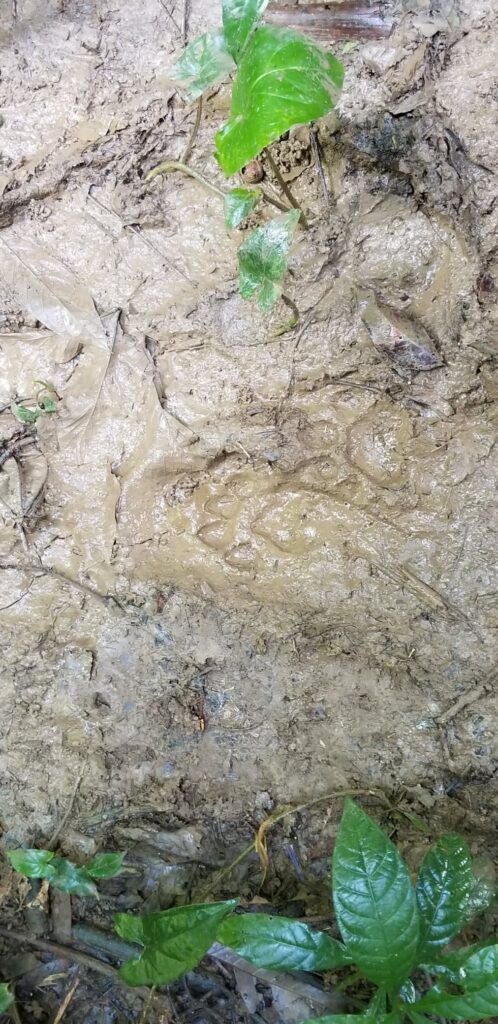
He points down to the jungle floor and there in the mud are jaguar prints and they’re relatively fresh, still glistening with moisture. My wife’s “wow” was almost yelled, my wow is practically whispered. There are wild jaguars in this part of the world and according to the wildlife agencies their numbers are stable. Raymond tells us they’re quite leery of humans and as long as there’s a healthy environment and plenty of Pacas, fish, and iguanas to eat, humans have little to fear from jaguars. The sound of Chiqa crunching through those chicken bones is still fresh in my mind and for the rest of our hike I felt the eyes of Chiqa’s relatives on the back of my neck. We were not in a zoo, a national park, or a protected area. We were just out in the open, walking through the rainforest on the edge of the Monkey River and we passed through the same space, stepped in the same puddle of mud as a wild Jaguar. I reach down and trace the outlines of this big cat’s paw and imagine that gorgeous Jaguar silently walking through this place, quietly placing one foot in the same space as the other, eyes and ears wide open, listening to the rainforest, hearing humans in the distance then leaping into the shadows. It was an absolutely extraordinary feeling of freedom. Wow indeed.
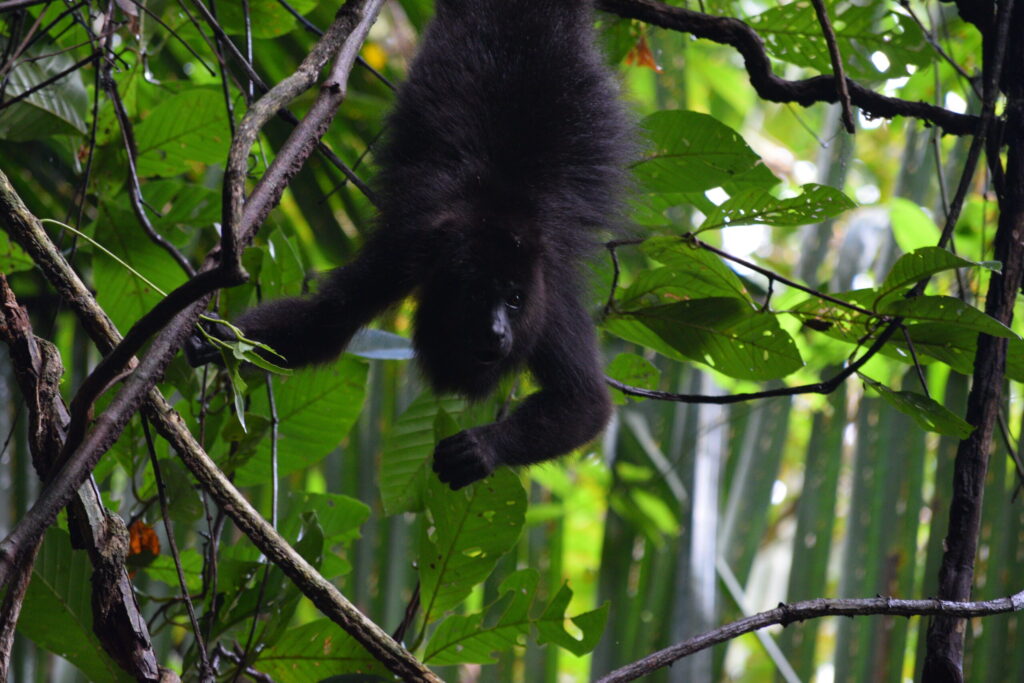
Now we’re closing in on a troop of Howler Monkeys. Raymond can hear them in the distance and he’s asking us to hurry up a bit. He’s trying to flank them before they cross the river. We can hear them in the distance, they’re not howling, we just hear them rustling through the treetops. It takes us a solid ten minutes of hustling through the mud and undergrowth, me looking for snakes in the tree limbs, her looking over her shoulder for a giant Belizian tarantula. Raymond asks us to stop as the monkeys are now around us. He whacks the side of a big Cohune Palm and starts barking and the Howlers are moving all around us. We briefly spy a large female followed by a tiny baby monkey and they’re scooting over the treetops faster than we could’ve run. Raymond barks again and a large male answers back. More rustling, more shadowy figures dashing over our heads then one of them begins to come out of the shadows, the limbs bend, palm fronds twist and a full-grown Howler Monkey is suddenly twenty feet over our heads, twisting this way and that as he takes us in. His coat is incredibly clean, his fur is long like a Border Collie’s, except it’s stiff, like he’s just left the salon. Wait, he’s hanging upside down and that’s why his hair looks stiff. His eyes are dark and curious, and his face is expressive. Howlers are one of the few monkeys with prehensile tails and his tail is curling and uncurling as he moves around the trees, constantly searching for purchase. As he’s checking us out, he’s also casually twisting leaves off a tree and chewing them. Howlers get all the water they need from their diet of leaves, nuts, and fruit and rarely are seen on the floor of the forest. This one is basically watching his own version of Animal Planet while enjoying his breakfast. Another thirty seconds of watching us and he leaps away, quickly disappearing behind a canopy of palm and Kapok. Howlers are the second loudest animals on earth, only elephants are louder. Today, though we have not been graced by their loudest calls, only a series of grunts. We didn’t know this at the time and really heard them a few days later at Cotton Tree Lodge. Stay tuned for that story.
After we’ve parted ways with the Howlers, I ask Raymond if we’re headed back to the boat. We’re both eaten up with mosquitoes and I’ve got a nasty bite on my left thigh. Raymond insists on showing us a stand of bamboo and we oblige, not that we have a choice but to follow him. As we round a big Cohune Palm, there’s a huge cluster of its fruit nagging at eye level. It looks like the world’s largest cluster of grapes. The fruit, miniature coconuts, are medium brown, the color of caramel and about the size of a lemon. And this cluster must contain hundreds of the fruit. Raymond yanks one off, holds it in his palm and while the professional chef in me cringes, he cracks it open with that four-foot-long machete. The blade goes in about an inch then he twists and pops it open. He offers us a split palm frond to eat the fruit.
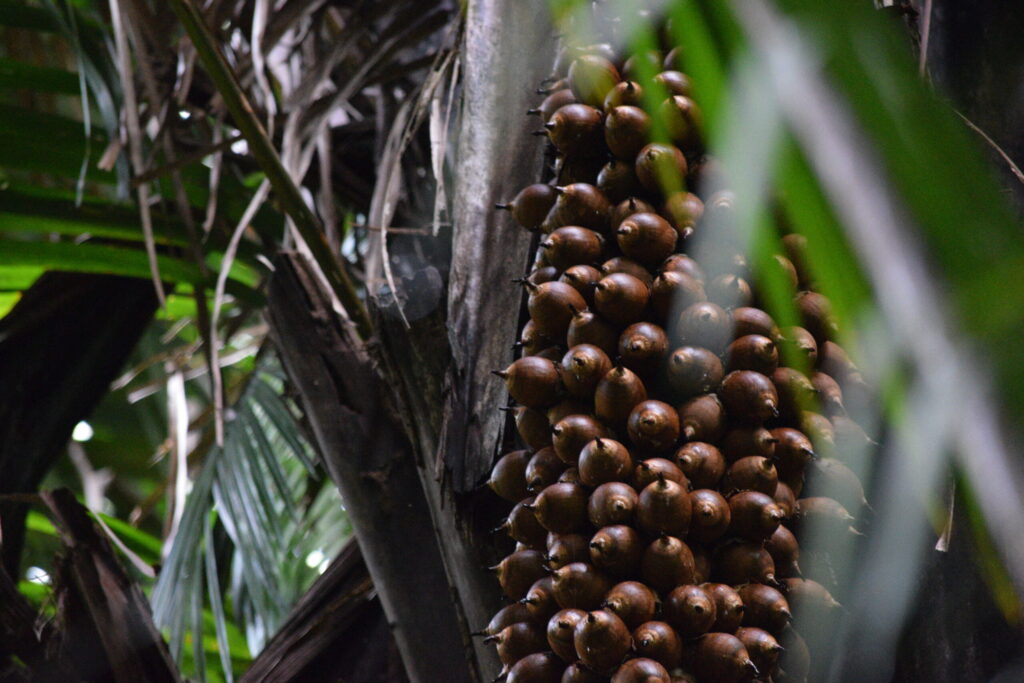
Cohune Palm was an important food for the Mayan. The fruit is rich in fat and water and they’re so prolific, everywhere we look there’s Cohune Palm. We dip our leaf in and enjoy. The fruit is lychee soft and practically quivers, its flavor is akin to a mild coconut, it’s tropical with slight notes of canary melon, a Vino Verdhe to a coconut’s powerful Cote de Beaune and we’re looking at hundreds of these little wine glasses of fat and water. All the calories one would need to hike through the rainforest are within an arm’s reach, just so long as those machete skills are on point. The mosquito welts on my wife’s arms appear to have doubled in number while we’ve been motionless, and I suggest we keep moving.

Guadua Longifolia is the sole native Bamboo in Belize and it prefers a life along a riverbank. Raymond takes us to a circular growth of bamboo and its individual shafts are as thick as Mike Tyson’s biceps, circa 1995 and those shafts of brilliant green reach sixty feet high. He pries open a few shafts and we step inside of this circle.
“The university students used to set up their cameras around here and some of them would spend the night here, stretching their hammocks between the bamboo. “
Amy is shaking her head back and forth, tightly gripping her tarantula death stick.
“Nope. You’re going to give me nightmares, Raymond.”
Raymond gently laughs and mumbles something about sleeping peacefully for many years. At that one of the Howler Monkeys, now some distance away, begins to bark, almost a laugh. Raymond turns an ear then shakes his head and we’re moving again. Thirty feet later he whispers “Stop” and crouches down.
“Red Antelope. There.”
Perhaps 200 feet in front of us I catch glimpses of rusty red fur, maybe three feet high. I can hear their feet gently crunching over the dry palm fronds. My camera is clicking away but the animals are in the distance, on the move and we’re in thick mud.
“Red Brocket deer. We call them antelope because of their size. I haven’t seen antelope here in many years. Did you get your photo?”
I doubt it but I give Raymond a thumbs up. Alerted to our presence, the deer are travelling away from us and making good time.
“Well let’s follow then because they’re heading to the boat.”
We’ve been in the forest for 90 minutes, traveling in figure eights, and we’re a muddy, sweaty, mosquito-bitten mess. In a few minutes we’re slipping and sliding into Ian’s boat, guzzling our water and answering Ian’s questions with smiles and thumbs up.
“Ian, we saw a Jaguar print!”
“Oh Miss Amy, that is a good thing to see.”
Ian opens the throttle and we’re heading to a delicious lunch of Recado braised chicken with cabbage slaw and rice at Alice’s Restaurant in the village. After that we part ways with Raymond. We offered him a nice tip as well as our compliments for an extraordinary four hours of sightseeing. Raymond likely never went to school as you and I did. His knowledge of the rainforest, of his home and its flora and fauna was complete from dirt to treetops and beyond and I can imagine those university students (hopefully) being equally amazed by this humble man. When Covid19 no longer creates overwhelming fear on our planet, Raymond is looking forward to entertaining more university students.
On our way back to Placencia Ian offers to show us manatee. My bride is thoroughly covered in the rainforest’s many woes yet she’s up for one more adventure.
“Oh yes please!”
Ian takes us near the shore of Harvest Caye, a private island owned by Norwegian Cruise Line. As we drift near this island’s ridiculous Disneyesque collection of zip lines and climbing walls my cynicism levels hit the redline. This island is marketed as a Belizian experience yet it’s not in Belize. It’s a private, polished, sanitized version of Belize with all the charms, aromas, and potential dangers of Belize removed. And now it sits quietly, slowly rusting, waiting for the world to be “safe” for travel again.
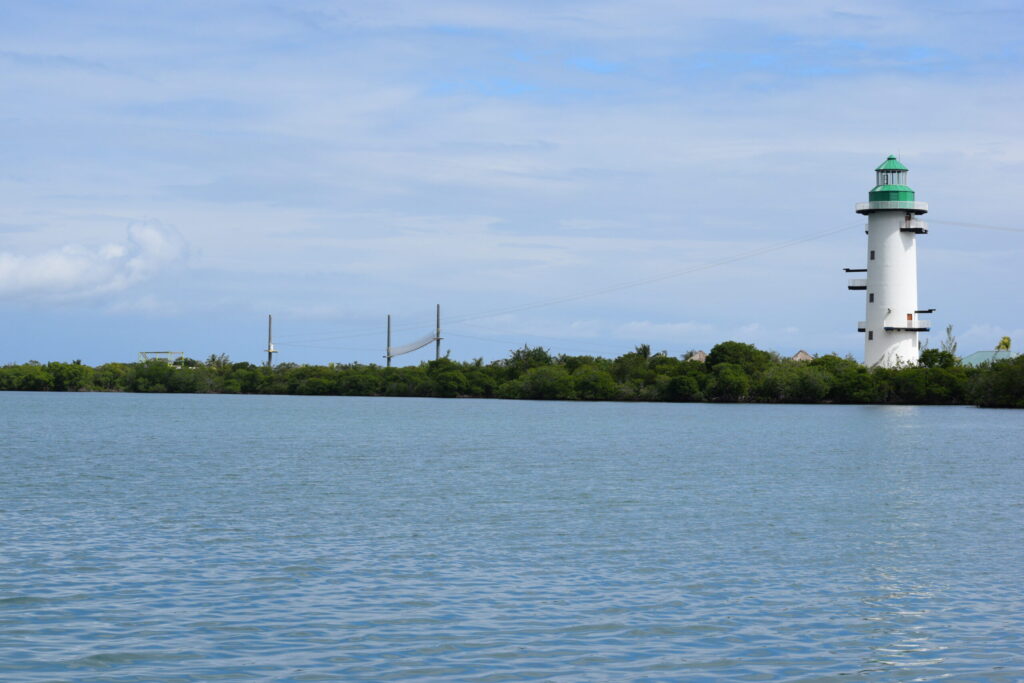
After a few minutes of listening and watching, Ian spots manatees and I lurch out of my cynicism. The manatees are breaching forty feet in front of us. It’s a mother and her young calf and their bodies don’t break the surface, it’s a slow, gentle breach as if the water is mounding itself then easing back into the sea. Their skin is a mottled green and grey and blue and they move with the languid energy of a banana ripening. It’s no wonder they don’t mix well with power boats and their drunk skippers in the watery highways of south Florida. Ian gently moves the boat here and there as he spots another small pod of manatee, always staying a respectful distance from these mammals.
“I’ve seen photos of people handling these underwater. I never recommend that. These animals need to stay wild and keep their distance from humans and remain wild animals.”
We both agree and soon we’re back on the throttle, headed to the docks of Placencia. We’ve been on the water and in the mud for over six hours and we are exhausted, and thrilled, and amazed at what we’ve seen, what we’ve heard.
That night, softly ensconced in the luxurious linens of Caribbean Beach Cabanas, we reminisced about that day in June when I first floated this idea.
“Suppose we moved to Belize for a year?”
We were tucked into bed, waiting for the night to cover us in dreams and with my words she was jolted awake.”
“Wait…do what!?”
“I’ve been talking to Bob Calder, and well, it could be quite an adventure.”
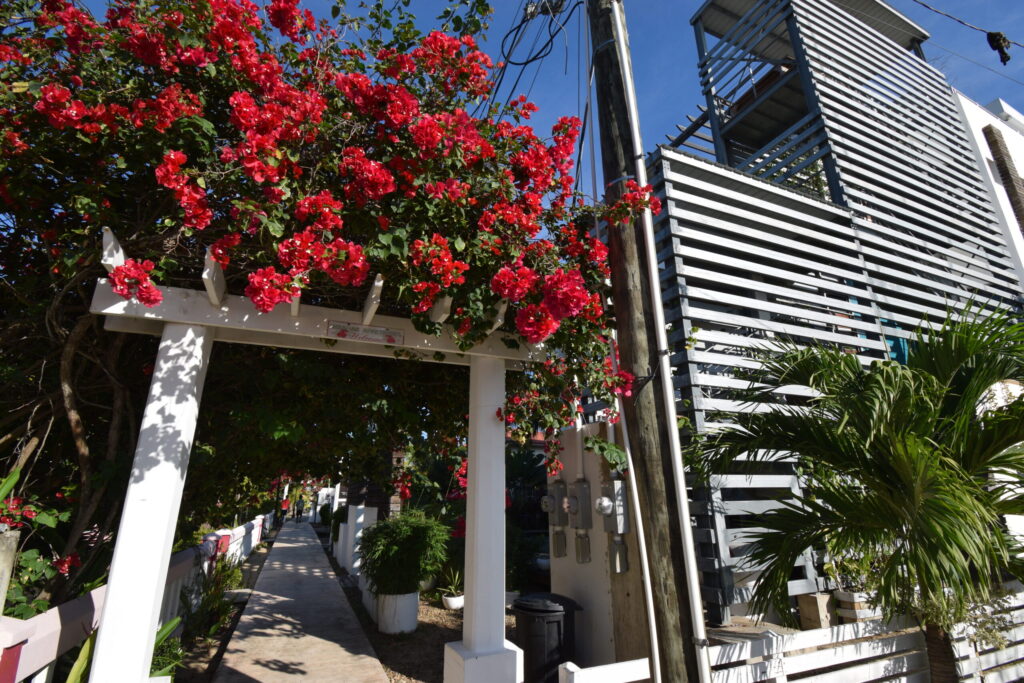
Quite the adventure indeed.
~ John
Truly Wild Belize Adventure Tours
You’re reading the year-long adventures of John & Amy Malik in Belize, Central America. We’re professional chefs, restaurant owners, food & travel writers, adventurers, (former) tent campers, and hikers. We prefer authentic street food over a steakhouse, craft beer over traditional lager, a glass of Spanish Garnacha over California Merlot. Should you feel so inclined, please share this essay with someone you’d take on a rustic adventure, and sign up for our next dispatch from Belize. Just click here.
Recado Braised Chicken
Ingredients
Whole Chicken, cut into eighths, fatty skin removed
Recado, four ounces
Yellow Onion, diced
Two carrots, peeled and large dice
Garlic Cloves, at least one dozen, peeled and rough chop
Ancho Chilis, two, whole
Habanero pepper, one, cut in half, seeds and stem removed
Chicken Stock, one quart
Salt & Pepper, pepper should be fresh ground, salt is always flakes of Kosher
Season the chicken liberally with the salt and pepper.
In a large cast iron skillet over high heat, crisp the chicken fat and skin to render the fat. When this is achieved, sear the chicken pieces until skin is crispy and light brown.

Place the seared pieces into your crock pot or large casserole dish.
Place the vegetables into the hot skillet and sear until the vegetable’s edges are light brown, crispy, and give off a sweet aroma.

Add the vegetables to the chicken dish.
Add the chiles to the chicken dish.

Add the Recado to the hot skillet then add the chicken stock and bring to a boil, stirring with a whisk to smooth out the Recado.

Cover the chicken with the hot and red chicken stock.
Cover the dish, place in a 350 F oven for two hours, or cook in the crock pot about four hours at medium.
Enjoy with fresh rice and a cabbage and vinegar slaw.


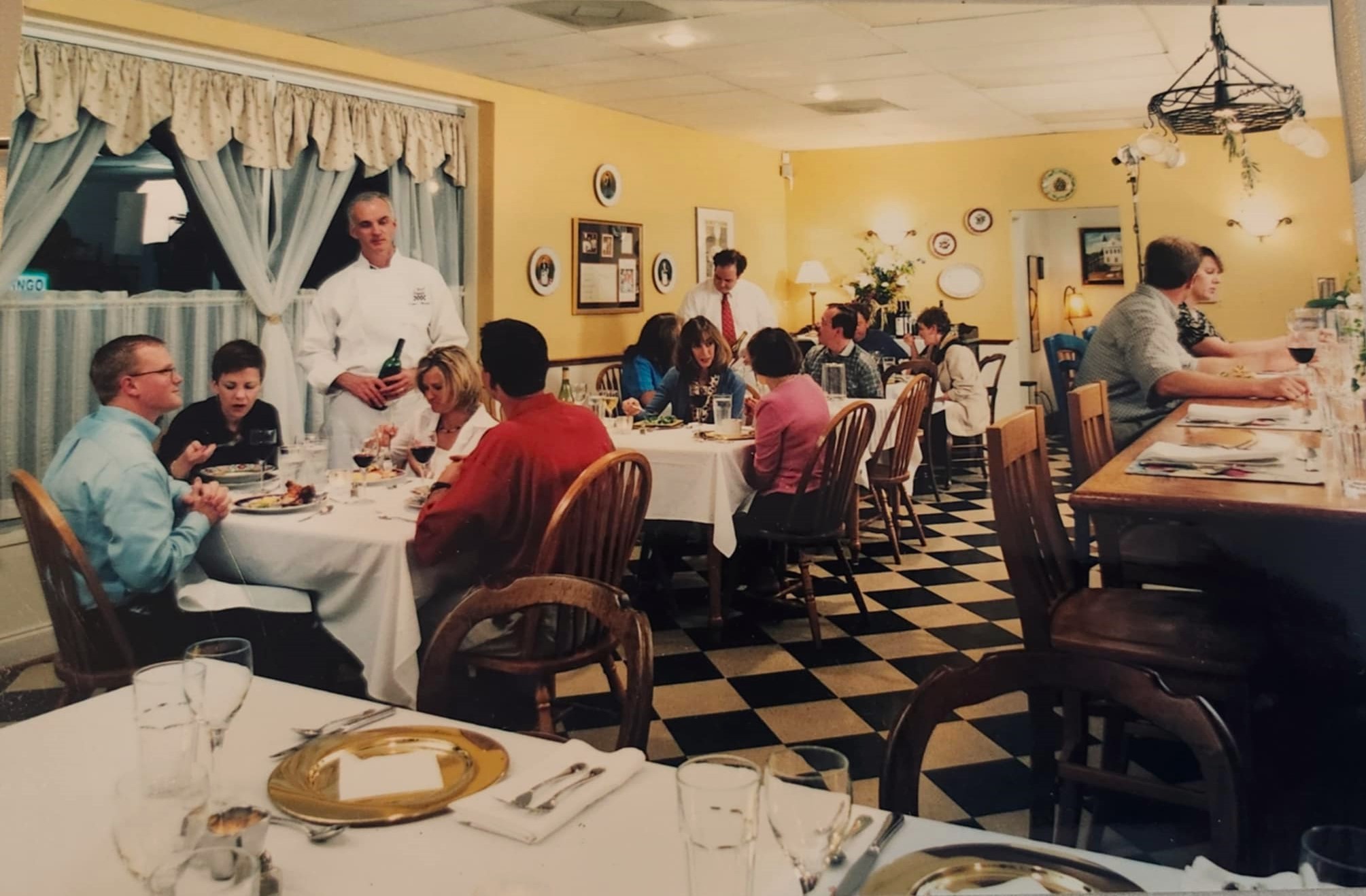

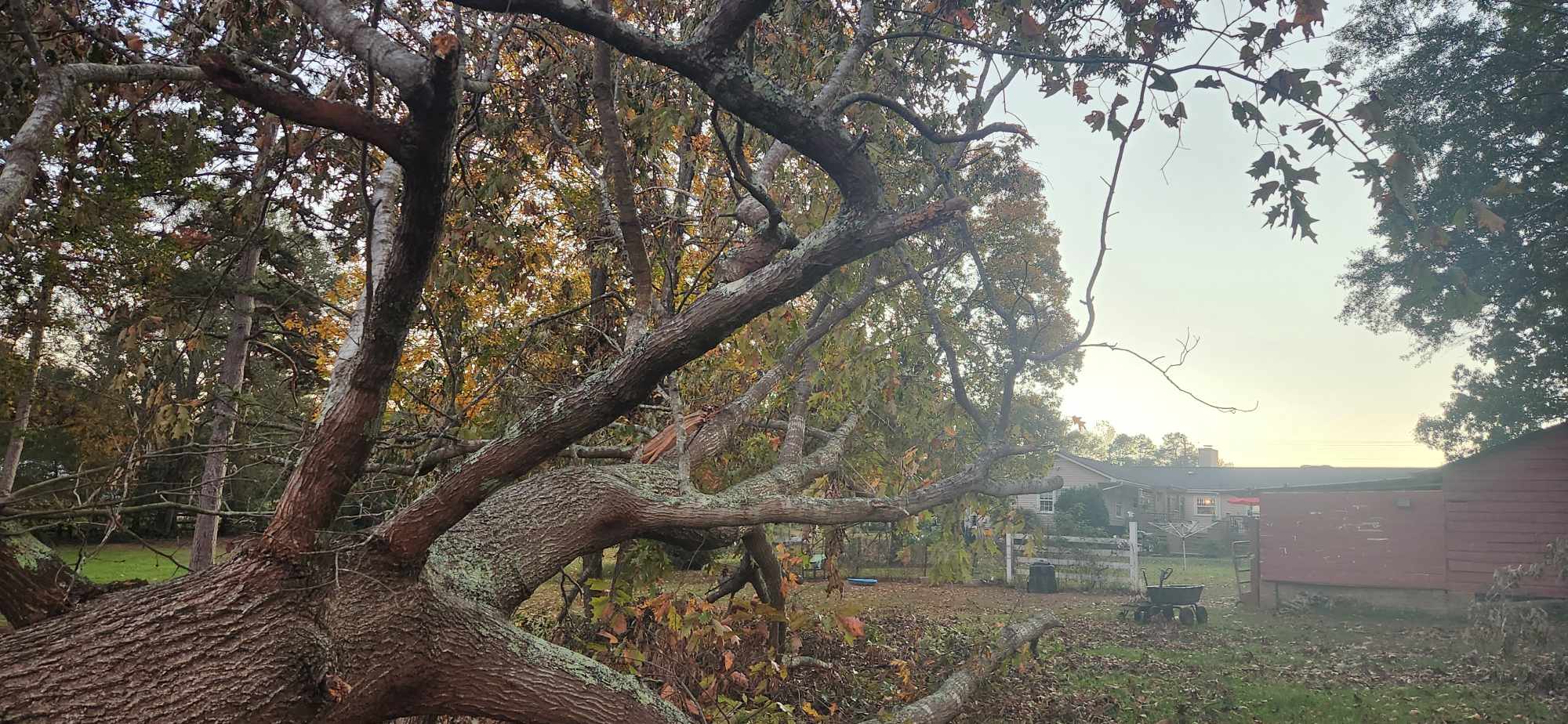
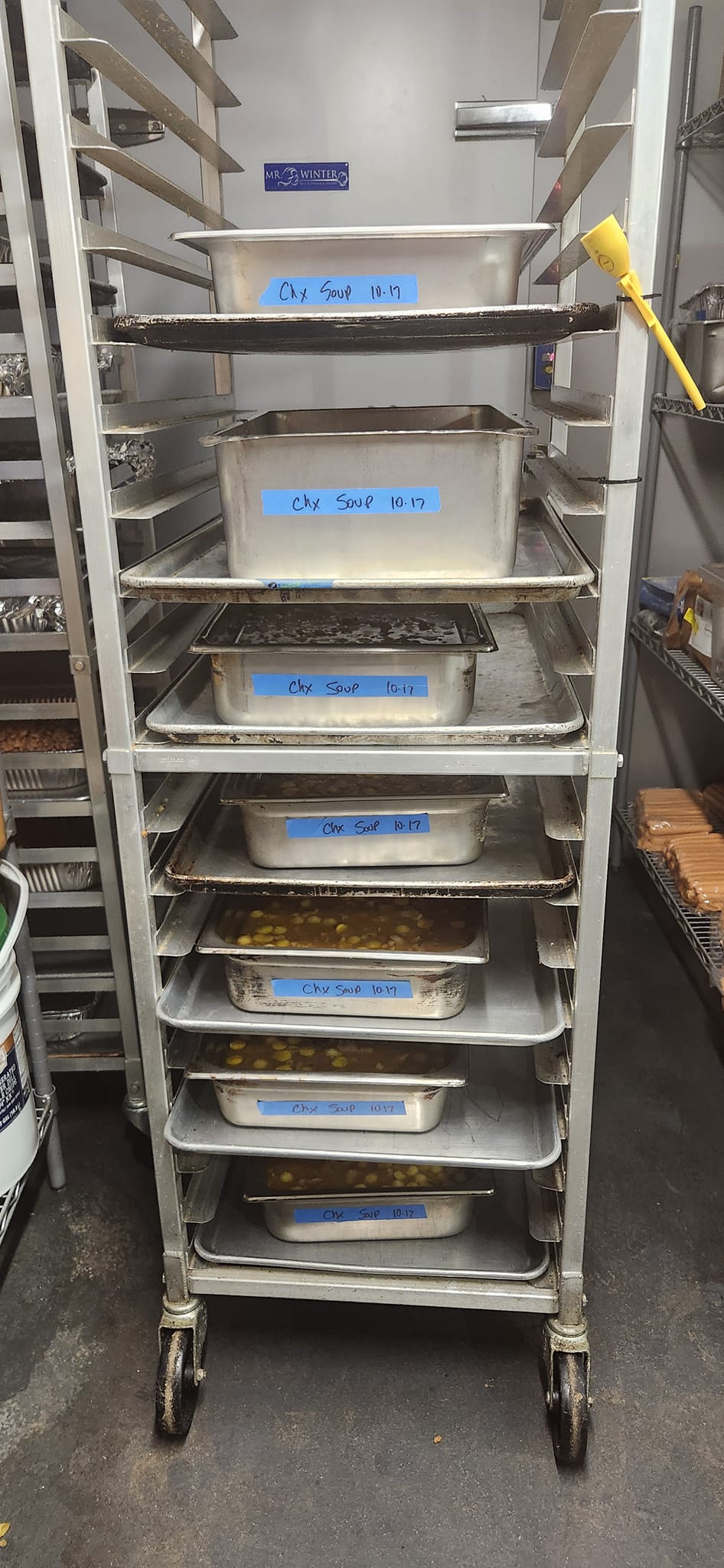
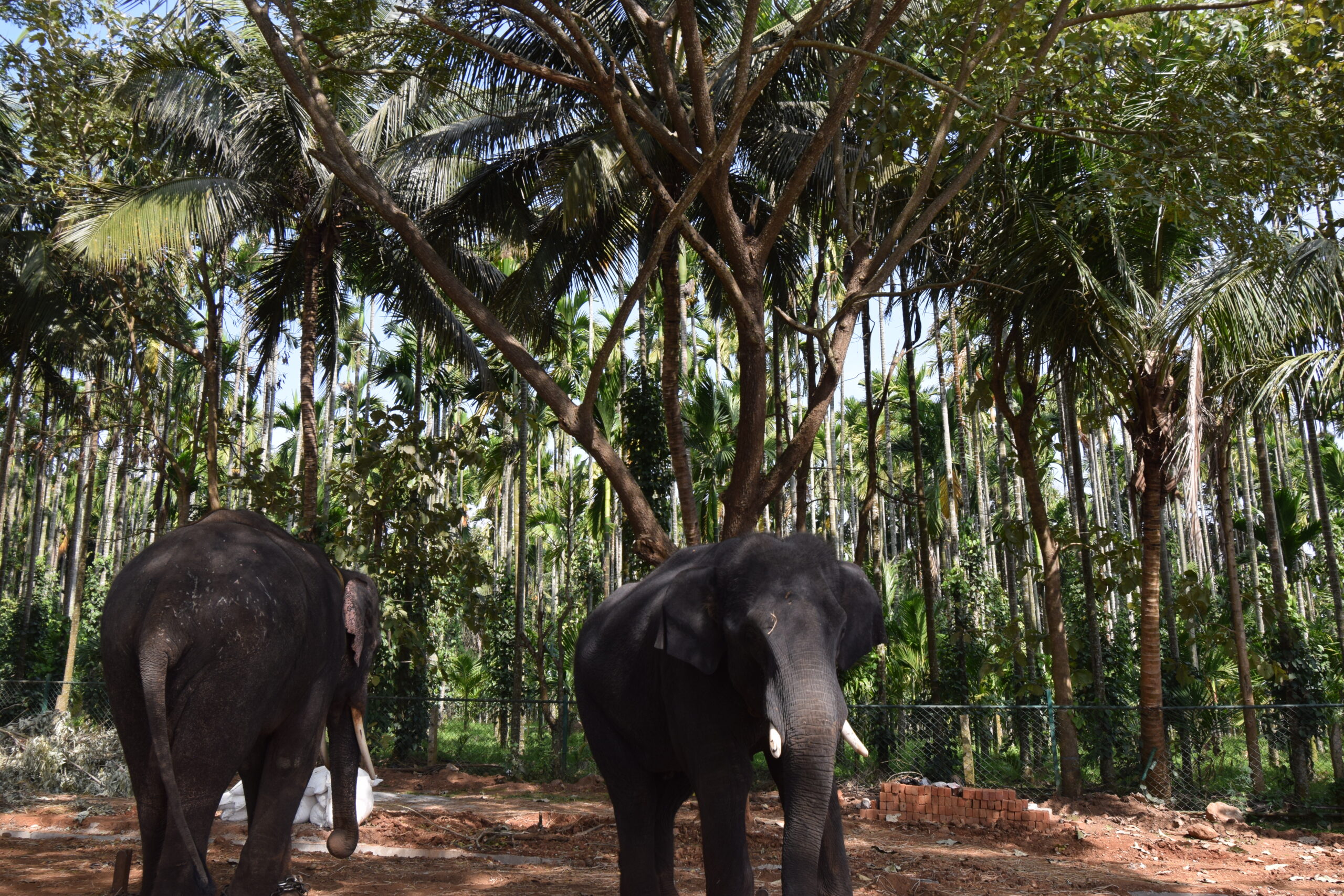
4 Responses
Awesome adventure & what exactly is recada?
An aromatic paste of herbs and vinegar used to flavor stews and the ubiquitous chicken dish.
Sounds like you’re having an interesting visit in Belize! Mangrove forests can get really thick and spooky! We look forward to your next adventure zoom. Stay well, be happy…. these are precious memories you both are making together! Be well and stay safe you guys! Love, hugs and prayers?❤️ Joyce and Duane Fofd
thank you very much, Joyce